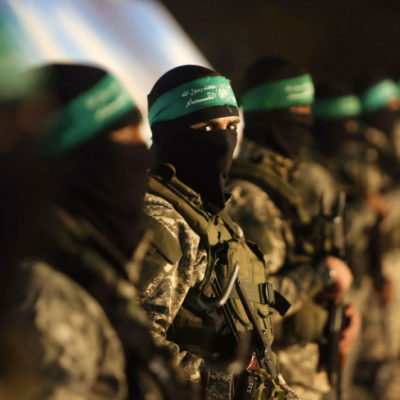Political and Security Development in Yemen
On 15th of January 2015, the Houthis raided the house of President Abed Rabbo Hadi Mansour, surrounded the presidential palace, stormed the presidential compound and seized missile camps and media. Their alliance with the Congress Party and its leader, Ali Abdullah Saleh, officially appeared. The Houthis issued a constitutional declaration on 6th of February 2015, dissolving the parliament and forming revolutionary committees to lead the country, which have received no international support.
The Houthis expanded the territory they control to include all the governorates of Yemen with high population density, especially the provinces of what was known as “North Yemen,” and reached the southern provinces, and broke into the city of Aden, under the pretext of fighting terrorism, especially Al Qaeda.
On 25th of March 2015, Saudi Arabia announced the formation of a military-political alliance with the aim of eliminating the “Houthi coup” power in Yemen, announcing its leadership of the alliance which launched its military operation “Operation Decisive Storm”. The alliance included the UAE, Kuwait, Qatar, Egypt, Pakistan, Jordan and Morocco; the coalition members together participated in “Operation Decisive Storm in Yemen”.
John McCain: The Arab military Operation in Yemen confirms a lack of trust Arabs in the United States”
The participation of the Arab parties in the military campaign, which quickly changed its name on the 16th of April to “Operation Restoring Hope”, was the main operational burden on Saudi Arabia and the UAE. Egypt participated in securing the Suez Canal crossing through Bab al-Mandab. The US declared its rejection of the Houthi coup backed by Iran, it also helped the coalition with logistic support.
On July 14, 2015, the “People’s Resistance” advanced and took control of Aden airport. By July 22, the city had regained full control. The Yemeni government said it had begun the “The Operation Golden Arrow” to free the rest of the area seized by the Houthis.
The war in Yemen has left about 10 thousand dead and more than 26 thousand wounded, while displaced about 2.4 million Yemeni persons by the end of 2015.
War continued and the Yemeni forces succeeded in supporting the UAE in expelling the Houthis from all areas known as South Yemen. The forces increased pressure to secure the coastline overlooking the Red Sea.
Yemeni forces have made slow progress in northeastern Yemen, supported by Saudi forces, and have succeeded in putting pressure on the Houthi strongholds in the north towards the Sa’ada and Hajja governorates.
On the other hand, the Houthis fired dozens of ballistic missiles towards the main cities of the KSA, all of which faced air defense batteries, while some of the houses of Saudi citizens near the border (Jizan and Najran areas) were damaged.
The Houthis disagreed with the Congress Party run by Ali Abdullah Saleh. The crisis ended with Saleh’s death and his burial in his hometown without ceremony. The UAE has intensified its pressure on the Houthis on several fronts since Saleh was killed.
KSA, UAE and the US regard the Houthis as an Iranian attempt to encircle Saudi Arabia, while Tehran says that Houthis is a blessed movement as a result of decades of marginalization and sectarian exclusion.
The military campaign, according to observers, is linked to huge changes in the governance environment in Saudi Arabia with the accession of King Salman, and the escalation of his son to be the youngest crown prince in the history of the Kingdom since its inception.
In early December 2017, the Houthi-Saleh alliance broke down, culminating in the killing of former President Saleh on December 4, 2017. Since Saleh’s death, the alliance has made military gains and advanced north along the Red Sea coast towards the port of Hodeida. However, the Houthi forces are still involved in northern Yemen and remain in control of the capital.
This led to the end of the ability of the central state to take full control of Yemeni lands, whether represented by the Houthis or the government of President Mansour. It also led to the collapse of the Yemeni economy, making it one of the largest choleras in the world. Yemen recorded more than one million cases by the end of 2017. Despite the low frequency of the pandemic, the UN warns of a strong return of cholera due to a huge shortage of sanitation and drinking water in most Yemeni governorates.
Groups of al-Qaeda appeared in Yemen, especially in the south, while al-Qaeda in parallel has returned to the Muslim Brotherhood since the beginning of 2017 attempt to reform its relationship with Saudi Arabia and the UAE, and focus on their coalition to eliminate the Houthi coup power.
Yemen’s sovereign institutions (the security forces – the army – the central bank – the ministries) lived a sharp split. The central bank was transferred to Aden as a “temporary capital”. There have been separatist tendencies in the south, with the support of some regional actors (the UAE) for such actions. And the emergence of disputes between the parties of the coalition of legitimacy, reached the level of fighting in the southern provinces, especially Aden.
We can say that the war in Yemen has exacerbated the humanitarian crisis in Yemen, which began in 2011, as of January 2019, more than half the population needed emergency food aid. Restrictions on access to certain areas of Yemen make it difficult for governments and aid agencies to account for war losses. Some official reports indicate that 60,000 Yemenis have been killed since January 2016. UNHCR estimates that 3.9 million Yemenis have been internally displaced as of January 2019. In January 2019, the UN Panel of Experts on Yemen issued its annual report covering 2018. In the “slide towards humanitarian and economic disaster”. Although the actual ground war remains confined to “relatively small areas,” the impact of the conflict on the economy, as well as the growing presence of armed groups and deep corruption have affected ordinary Yemenis within areas controlled by the Houthis and liberated areas.
Stockholm Agreement
The White House and Saudi Arabia were under heavy pressure after Khashoggi’s death, as Western powers withdrew their support from the coalition in an attempt to prove their dissatisfaction. Both Germany and Norway have suspended arms exports to Riyadh and the US Senate has decided to end its support for the conflict.
In accordance with UN Security Council Resolution 2451 of December 2018, and in support of the agreement signed in Stockholm on 6th of December 2018 and known as “Stockholm Agreement”, which resulted from the Yemeni state dialogue with the Houthi militia in Sweden, the UN Team began its mission in Yemen just few days after the gaining the trust from the UNSC for the Implementation of the Swedish Agreement between the Yemeni Parties.
The agreement includes three provisions:
- A cease-fire around the port city of Hodeida.
- A prisoner swaps.
- A statement of understanding that all sides would form a committee to discuss the war-torn city Taiz.
Despite the support of the international community for the implementation of the Stockholm Accord outcomes, several points may arise which may hinder or at least impede the implementation of its provisions as follows:
1. There are several points in the agreement written in an open manner to interpretations by belligerents. Including: “the mutual redeployment of forces from the city of Hodeida and the ports of Hodeida, Sulaif and Ras Issa”. The Houthis may take this interpretation as removing the military presence but not withdrawing, while the other side believes that the Houthis must withdraw completely.
2. The schedule of implementation is very tight, with the delivery of ports to the police within two weeks of the agreement (by the end of 2018) and to the local authorities within three weeks, which may be difficult to implement. And for which identity the police will belong to.
3. The possibility of re-opening Sana’a International Airport, as well as the reunification of the Central Bank of Yemen, has not been resolved.
For nearly two months, implementation of the Stockholm Agreement stalled. However, on February 17, the UN announced that “The parties reached an agreement on Phase 1 of the mutual redeployment of forces” whereby the Houthis would withdraw from Hodeida port and the Saudi-led coalition would move out of the eastern outskirts of Hodeida city. Still, the warring parties have yet to agree on the identities of local police forces to take over security in Hodeida. As of March 2019, the parties had made “significant progress towards an agreement to implement phase one of the redeployments of the Hodeida agreement.”
Until a final redeployment is reached, the Houthis remain ensconced in Hodeida, with barricades, trenches and roadblocks still present throughout the city. The Houthis want local coast guard units to assume control. The coalition claims, however, that the leaders of the local coast guards are loyal to the Houthis, and U.N. observers may have difficulty in verifying the neutrality of security personnel in Hodeida. U.N. officials have reported to the Security Council that the Houthis fear that a withdrawal from Hodeida will make their forces vulnerable to attack by the coalition.
Meanwhile, in Jordan, several meetings between the Houthis and the Hadi government have taken place over a planned prisoner exchange as called for in the Stockholm Agreement.
Although some exchanges of wounded personnel and prisoners have taken place, the talks have not produced a comprehensive agreement to date.
Since the signing of the Stockholm Agreement, the Saudi-led coalition has conducted airstrikes in Sanaa in retaliation for a Houthi drone attack against a Yemeni military parade. In late January, artillery fire struck a camp for internally displaced people in Yemen’s northwestern Hajjah province, killing eight civilians and wounding 30 others.
A lack of trust and a reluctance to make operational concessions outside of a comprehensive political agreement is previously the common feeling to all parties now.
Iranian Support to Houthis
Although Houthi militia forces most likely do not depend on Iran for all of their armaments, financing, and manpower, many observers agree that Iran and its Lebanese ally Hezbollah have aided Houthi forces with advice, training, and arms shipments. In repeated public statements by high-level Saudi officials, Saudi Arabia has cited Iran’s illicit support for the Houthis as proof that Iran is to blame for the Yemen conflict. Reports and allegations of Iranian involvement in Yemen have become more frequent as the war has continued, and from Iran’s perspective, aiding the Houthis would seem to be a relatively low-cost way of keeping Saudi Arabia mired in the Yemen conflict. However, Iran had few institutionalized links to the Houthis before the civil conflict broke out in 2015, and questions remain about the degree to which Iran and its allies can control or influence Houthi behavior. At present, Iranian aid to the Houthis does not appear to match the scale of its commitments to proxies in other parts of the Middle East, such as in Syria, Lebanon, and Iraq.
Prior to the 2015 conflict, the central government in Yemen had acquired variants of Scud-B missiles from the Soviet Union and North Korea. The Houthis took control of these missiles as part of their seizure of the capital. Reports say hat Iran also launched missiles from advanced posts on Saudi cities.
In summer 2018, the UN Panel of Experts on Yemen provided a confidential report to the UNSC suggesting that Iran may be continuing to violate the international arms embargo by supplying the Houthis with advanced weaponry.
After the U.N. experts visited Saudi Arabia and inspected debris from missiles fired by the Houthis, their report noted that these weapons showed “characteristics similar to weapons systems known to be produced in Iran” and that there was a “high probability” that the missiles were manufactured outside of Yemen, shipped in sections to the country, and reassembled by the Houthis.
In May 2018, the U.S. Department of the Treasury’s Office of Foreign Assets Control (OFAC) designated five Iranian individuals who have “provided ballistic missile-related technical expertise to Yemen’s Houthis, and who have transferred weapons not seen in Yemen prior to the current conflict, on behalf of the Islamic Revolutionary Guard Corps-Qods Force (IRGC-QF).
The U.N. Panel of Experts on Yemen reported in January 2019 that the panel “has traced the supply to the Houthis of unmanned aerial vehicles and a mixing machine for rocket fuel and found that individuals and entities of Iranian origin have funded the purchase.
The U.S. Involvement
I the beginning some Republican Senators in the US Congress declared their denial to launch the Arab military operation in Yemen as it expresses a lack of trust on the US; however, later, according to the KSA requests, President Obama authorized “the provision of logistical and intelligence support to GCC-led military operations. Obama Administration announced that the US would establish “a Joint Planning Cell with Saudi Arabia to coordinate U.S. military and intelligence support.” U.S. CENTCOM personnel were deployed to provide related support, and U.S. mid-air refueling of coalition aircraft began in April 2015 and ended in November 2018.
In 2019, the US has continued to cooperate with Saudi Arabia and the UAE in countering terrorism and attempting to limit Iran’s influence in Yemen. For the Trump Administration, U.S. officials have supported the continued defense of Saudi Arabia against Houthi missile and rocket strikes, while also openly calling on coalition members to use air power judiciously to minimize civilian casualties. After ending U.S. refueling support at the coalition’s request in November 2018, the Administration has argued against congressional attempts to block arms sales or to end or condition U.S. assistance, arguing that continued U.S. assistance is more likely to achieve the objectives of limiting civilian casualties and maintaining strategic ties to Gulf partners than a punitive approach.
On November 11, 2018, the US halted in-flight refueling support for coalition aircraft at the request of the coalition.
In January 2019, the 115th US Congress meeting approved the S. 398, of the Saudi Arabia Accountability and Yemen Act of 2019. This bill required the end of in-flight refueling for Saudi-led coalition operations in Yemen, suspend certain arms sales to the kingdom, sanction persons blocking humanitarian access in Yemen, and sanction persons supporting the Houthis in Yemen.
On 12 and 13th of February 2019, the Meeting ‘Confronting Iran” held in Warsaw, attended by representatives of 60 countries to coordinate the policy of stockholders in Yemen (US, UK, KSA and UAE) toward the Yemen conflict.
They emphasized the importance of implementing the Stockholm Agreement, the problematic role Iran plays in arming and financing the Houthis, and the need for additional humanitarian assistance. The foreign ministers comprising the quad also “expressed full support for Saudi Arabia and its legitimate national security concerns and called for an immediate end to such attacks by Houthi forces and their allies.
Counterterrorism Operations in Yemen:
As the Saudi-led coalition campaign against the Houthis continued, the US continued its counterterrorism operations against al-Qaeda in the Arabian Peninsula (AQAP) and Islamic state (ISIS). In general, the US Central Command conducted 36 air strikes on Yemen in 2018.
Observers believe that the AQAP in Yemen has shrunk to a large extent as a result of losses incurred by US counterterrorism operations and the fighting of Yemeni factions competing for sovereignty in the country.
Yemen’s Humanitarian Crisis
Humanitarian Conditions and Assistance
According to the United Nations, Yemen’s humanitarian crisis is the worst in the world, with close to 80% of Yemen’s population of nearly 30 million needing some form of assistance. The U.N Office for the Coordination of Humanitarian Affairs (OCHA) estimates that two-thirds of the population is food insecure, one-third are suffering from extreme levels of hunger, and 230 out of Yemen’s 333 districts were at risk of famine as of January 2019. In sum, the United Nations notes that humanitarian assistance is “increasingly becoming the only lifeline for millions of Yemenis.”
As noted above, on February 17, the parties to the conflict began to implement the Stockholm Agreement. The deal calls for main roads to reopen from Hodeida to Sana’a and Taiz and humanitarian access to the Red Sea Mills grain storage facility, which holds enough grain to provide food for 3.7 million Yemenis for a month. Access to the Mills has been cut off since September 2018.
On February 26 in Geneva, the United Nations and the Governments of Sweden and Switzerland hosted the third annual pledging conference for the crisis in Yemen. Saudi Arabia and the UAE each pledged $750 million. For 2019, the United Nations is seeking $4 billion from donors for programs in Yemen. The 2018 humanitarian appeal sought a little over $3 billion, of which donors have provided $2.58 billion to date. The US, Saudi Arabia, the UAE, and Kuwait combined accounted for 66.8% of all contributions to the 2018 appeal.
Future of Yemen
Possible dividing of Yemen
The complexity of Yemen’s internal politics and the short-term need to resolve the current conflict have overshadowed domestic and international consideration of what the future of Yemeni governance may be. Overall, the prospects for returning to a unified Yemen appear dim. According to the United Nations Panel of Experts on Yemen, “The authority of the legitimate Government of Yemen has now eroded to the point that it is doubtful whether it will ever be able to reunite Yemen as a single country.”
The complexity of Yemen’s internal politics and the short-term need to resolve the current conflict have overshadowed domestic and international consideration of what the future of Yemeni governance may be. Overall, the prospects for returning to a unified Yemen appear dim. According to the United Nations Panel of Experts on Yemen, that he authority of the legitimate Government of Yemen has now eroded to the point that it is doubtful whether it will ever be able to reunite Yemen as a single country.
I think that there are three conflicts in Yemen, not just one:
First: An internal conflict between various political forces of Yemen.
Second: The rivalry between Arab partners on the strategy and the strategic goals.
Third: Conflict that imposes its imprint or serves as ideological, is a standoff between Saudi Arabia and Iran.
We should consider that completion of one of these conflicts does not mean the end of the other two. Therefore, for the time being, we have a crisis, the settlement of which is not possible in the short term.
Possible Scenarios in Yemen
In the current circumstances and the determination of the international and regional powers to achieve their cross-cutting interests in Yemen, I see that the situation in Yemen is in the process of three possible scenarios.
Scenario I
Coalition will continue fighting against the Houthis without ability of both parties to stand in their favor, which means the continuation of the arms race and loss of lives and money, which increases the incidence of poverty and internal economic deficit, in addition to further instability of the region as a whole.
Scenario II
Turning into direct war between the Saudi-led coalition and perhaps Israel on the one hand and Iran and its armed groups on the other, as a result of the very complex overlap of several regional and international powers in many geographical areas in the region, namely Syria, Yemen and Iraq.
Scenario III
Turning the military conflict in Yemen into political negotiations that could divide Yemen.
I think that the third scenario is the most likely in the future as a result of the following:
The difficulty of control by any individual regional power on Yemen as a result of their military conflict, specially their conflict exhausts their abilities severely.
The absence of most of the elements of power in any of the regional parties, and the rejection of the US and other major power states of the emergence of a regional power in the Middle East fully able to control the situation within the new regional format.
Sayed Ghoneim, Major General (retired)
Fellow, Nasser Higher Military Academy
International Security Consultant and Lecturer
www.igsda.org




